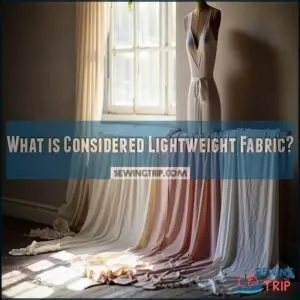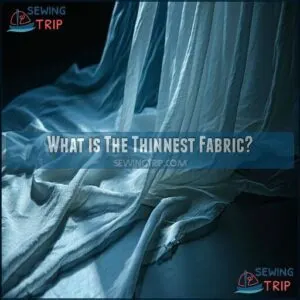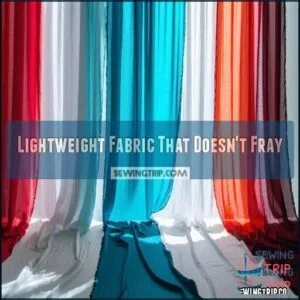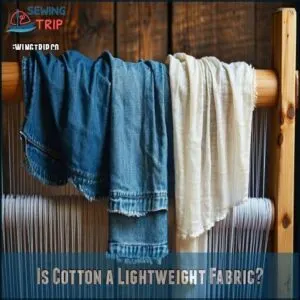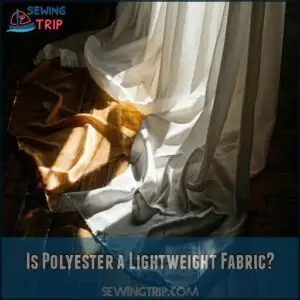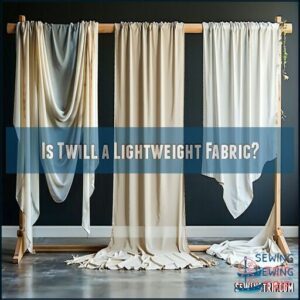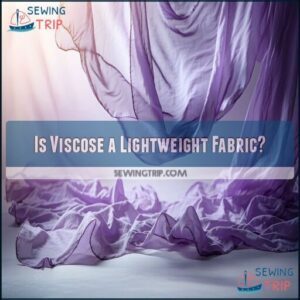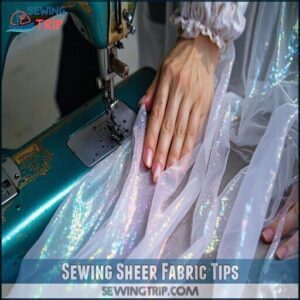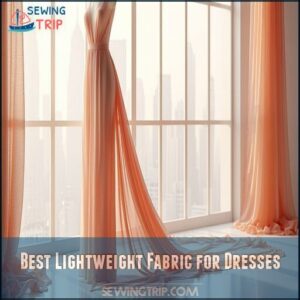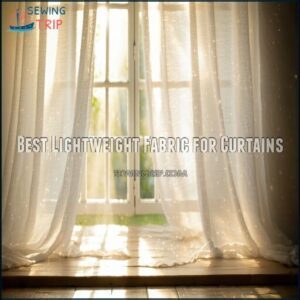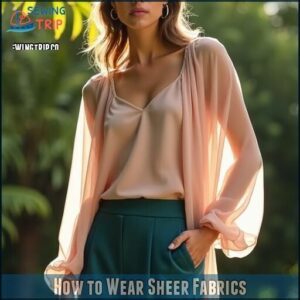This site is supported by our readers. We may earn a commission, at no cost to you, if you purchase through links.
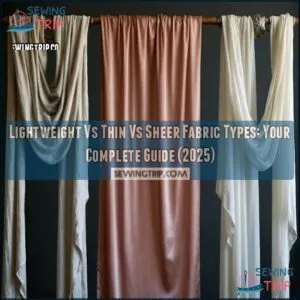 Lightweight, thin, and sheer fabrics might seem similar, but they each have their own vibe.
Lightweight, thin, and sheer fabrics might seem similar, but they each have their own vibe.
Lightweight fabrics, like cotton or linen, feel airy and are perfect for warm weather without being see-through. Lightweight fabrics balance comfort and breathability.
Thin fabrics are all about minimal thickness—think delicate silk or viscose, which drape beautifully but might need lining. Thin fabrics focus on texture.
Sheer fabrics, like chiffon or organza, are purposely translucent, adding a touch of elegance or boldness to outfits. Sheer fabrics let light through.
The key difference? Curious about the best picks for dresses or curtains? Let’s break it down!
Table Of Contents
- Key Takeaways
- What is Considered Lightweight Fabric?
- What is The Thinnest Fabric?
- Lightweight Fabric That Doesn’t Fray
- Is Cotton a Lightweight Fabric?
- Is Polyester a Lightweight Fabric?
- Is Linen a Lightweight Fabric?
- Is Twill a Lightweight Fabric?
- Is Viscose a Lightweight Fabric?
- Types of Sheer Fabric
- Sewing Sheer Fabric Tips
- Best Lightweight Fabric for Dresses
- Best Lightweight Fabric for Curtains
- How to Wear Sheer Fabrics
- Spring/Summer Sheer Trend
- Sheer Fabric Collection
- Frequently Asked Questions (FAQs)
- Conclusion
Key Takeaways
- Lightweight fabrics are breathable and comfortable, perfect for summer, with 30–150 GSM; think cotton or linen that is not see-through.
- Thin fabrics focus on minimal thickness, like silk or viscose, offering elegance but often requiring lining.
- Sheer fabrics are transparent, like chiffon or organza, ideal for layering or bold styles where light passes through.
- Know your fabric’s purpose: lightweight for comfort, thin for drape, and sheer for style or visual effects.
What is Considered Lightweight Fabric?
A lightweight fabric is like your favorite summer t-shirt – airy and comfortable. You’ll recognize these materials by their weight, typically falling between 30-150 GSM (grams per square meter).
Whether you’re choosing natural fibers like cotton and linen or synthetics like polyester, lightweight fabrics offer excellent drape that flows with your body. European manufacturers excel at producing delicate options including batiste, chiffon, and georgette crepe.
When working with lightweight fabric types, handle with care – tissue paper backing and fine pins are your best friends. These versatile materials work beautifully in lightweight apparel, either as standalone pieces or layered for interesting texture. They feature looser weaves that enhance breathability but may fray more easily than their heavier counterparts.
What is The Thinnest Fabric?
Now that you understand what makes a fabric lightweight, you’re probably wondering: what’s actually the thinnest fabric out there? Currently, Super Organza holds the title as the world’s thinnest fabric, weighing an astonishing 30 GSM (grams per square meter). That’s lighter than a feather!
Super Organza, the world’s thinnest fabric at 30 GSM, feels lighter than air—perfect for delicate, ethereal creations.
Many thin lightweight fabrics are suitable for dressmaking.
When comparing thin vs sheer fabrics, remember that thinness relates to fabric weight and physical thickness, while sheerness refers to transparency. The denier rating also helps determine a fabric’s transparency—lower numbers mean you can see through it more easily.
Other ultra-thin contenders include cotton voile, silk georgette, and batiste. These delicate materials often require special handling due to their lightweight nature.
Fabric transparency varies widely among these options, with some being completely see-through while others maintain a subtle translucence despite their minimal fabric weight.
Lightweight Fabric That Doesn’t Fray
When searching for fabric that combines lightness with durability, fray resistance becomes your best friend.
Knit fabrics like jersey naturally resist fraying due to their looped construction.
Woven options, such as synthetic choices like polyester and nylon, offer excellent fray resistance while maintaining lightweight properties (30-150 GSM). Tightly woven fabrics with strong seams, like eyelet cotton, provide remarkable fabric durability without adding weight.
For lightweight fabrics for dresses, consider microfiber or treated cotton blends that combine fabric weight efficiency with built-in fray protection.
Remember, the right fabric choice balances your need for both airiness and longevity.
Is Cotton a Lightweight Fabric?
Cotton isn’t simply lightweight or heavyweight—it varies widely based on its weave and processing. With GSM ranging from 30-150, cotton offers different weights for various needs.
Lighter cotton fabrics like lawn and voile provide excellent breathability while maintaining a nice drape, perfect for summer clothing. However, they’re not as sheer as fabrics like chiffon or georgette.
The cotton weave dramatically affects its weight—percale tends to be lighter than denim or canvas. When choosing cotton fabric, you’ll want to check both the GSM and weave type for your specific project.
Is Polyester a Lightweight Fabric?
Yes, polyester is indeed a lightweight fabric, with GSM typically ranging from 30-150. As a synthetic material, it offers remarkable versatility while maintaining a light feel.
Polyester Properties make it a popular choice for various applications:
- Incredible durability that withstands repeated washing without losing shape
- Excellent wrinkle resistance that keeps garments looking crisp throughout the day
- Quick-drying capabilities perfect for activewear and travel clothing
When shopping for thin fabric options, polyester alternatives like georgette, chiffon, and crepe blend the best of both worlds—lightweight construction with surprising strength. These sheer fabric varieties don’t fray easily, making them beginner-friendly for sewing projects.
Unlike some natural fibers, polyester maintains its structure without sacrificing weight. This balance of polyester durability and lightness explains why it’s so widely used in everything from fashion to home décor. You’ll find it’s especially valuable when you need something that won’t weigh you down but still performs reliably.
Is Linen a Lightweight Fabric?
While polyester offers synthetic versatility, linen stands as nature’s answer to lightweight fabric needs. Linen is indeed a lightweight fabric, typically ranging from 120-150 GSM for summer clothing.
The unique linen weave creates a fabric that’s both light and exceptionally breathable – perfect for those sweltering days when your clothes need to work as hard as you do. The fibers allow maximum airflow while wicking moisture away from your skin, keeping you cooler than most fabrics of similar weight.
What makes linen special is its impressive drape that enhances as it ages, unlike many synthetic alternatives.
Not all linen is created equal, though. Handkerchief linen is among the lightest variants, while heavier types are used for upholstery. For clothing, you’ll want to look for that sweet spot where linen remains thin enough for comfort without becoming sheer or transparent.
Is Twill a Lightweight Fabric?
Despite popular misconceptions, twill isn’t considered a lightweight fabric when compared to truly lightweight materials. Twill weave creates a durable, structured fabric that typically weighs more than the 30-150 GSM range that defines lightweight fabrics.
Here’s what makes twill different from lightweight options:
- Weight: Twill fabrics generally fall between 200-300 GSM, substantially heavier than sheer or lightweight materials.
- Structure: The diagonal weave pattern gives twill more body and less drape than lightweight alternatives.
- Durability: Twill’s tight weave creates a stronger, more robust fabric suitable for pants, jackets, and upholstery.
- Applications: You’ll find twill in workwear, denim, and home furnishings rather than flowing summer dresses.
When seeking truly lightweight options, consider alternatives like batiste, voile, or chiffon instead. Fabric weight comparison shows twill belongs firmly in the medium-weight category, offering substance where lightweight fabrics offer airiness.
Is Viscose a Lightweight Fabric?
As light as a summer breeze, viscose definitely qualifies as a lightweight fabric. Weighing between 30-150 GSM, this versatile material offers the perfect balance of comfort and durability. You’ll appreciate its cotton-like qualities with enhanced viscose durability that stands up to regular wear.
When comparing lightweight vs thin or lightweight vs sheer fabrics, viscose sits comfortably in the middle ground. Its natural viscose drape creates flowing silhouettes that move beautifully with your body. The excellent viscose breathability makes it ideal for warm-weather clothing when you want to stay cool without sacrificing style.
The viscose weight varies depending on the manufacturing process, giving you options from almost translucent to more substantial opaque versions. If you’re considering viscose alternatives, look at rayon or modal which share similar properties.
For care, simply wash at low temperatures to maintain the fabric’s integrity. Whether in pure form or blended with other fibers, this lightweight fabric delivers both comfort and elegance.
Types of Sheer Fabric
From gossamer-thin to moderately transparent, sheer fabric comes in numerous varieties to match your specific needs. When selecting transparent fabrics, you’ll want to weigh both appearance and functionality.
- Chiffon types range from silk (luxuriously soft with elegant drape) to polyester sheer fabric (more affordable with similar flow).
- Organza variations offer structured sheerness—perfect for overlays and formal wear with their crisp texture.
- Lace varieties provide decorative transparency with intricate patterns that add visual interest.
Other popular options include tulle uses in ballet costumes and wedding veils; voile properties that balance sheerness with stability; and gauze with its lightweight, breathable weave.
The sheerness of fabric meaning varies—from nearly see-through fabrics like batiste to semi-transparent georgette that provides more coverage while maintaining an airy feel.
For summer clothing, consider sheer fabric trends to create a stylish and breathable wardrobe.
Sewing Sheer Fabric Tips
You’ll need special techniques to tame those tricky sheer fabrics that love to slip and slide under your presser foot.
With the right needle size and proper tension settings, you can transform these challenging materials into beautiful, professional-looking garments.
Needle Size
Choosing the right needle size can make or break your sheer fabric projects.
For delicate materials like chiffon and georgette, reach for fine needles (sizes 8-11) that slip through the thin material without leaving holes. Remember that needle size directly corresponds to fabric weight—the lighter your fabric, the smaller your needle should be.
Universal needles work for most lightweight fabrics, while microtex needles offer precision for silk-like synthetics. You can find sheer fabric needle products online.
When working with batiste or voile, a size 9 needle paired with 60-weight thread creates nearly invisible stitches. Many sewists keep a variety of needle types on hand, switching between them as fabric thickness changes.
Your machine settings should complement your needle choice for best results.
Tension
Now that you’ve mastered the right needle size, getting your tension just right will make or break your sheer fabric project. Thread tension needs careful adjustment when working with delicate materials below 150 GSM. Specialty products can address sheer fabric tension challenges.
For perfect results with lightweight and sheer fabrics:
- Loosen your upper thread tension to 2-3 (rather than 4-5) to prevent puckering
- Check your bobbin tension is balanced with your thread tension
- Use a stabilizer underneath fabrics with low sheerness ratings to maintain even fabric tension
Test on scraps first—proper tension settings create beautiful, flat seams without damaging your delicate fabric.
Best Lightweight Fabric for Dresses
Discover the perfect lightweight fabrics for your dream dress by considering both style and function.
Batiste, georgette, chiffon, and crepe excel at creating flowing silhouettes with beautiful drape and movement. Each offers different levels of opacity and transparency – from semi-sheer to fully translucent.
Natural options like cotton and silk provide superior comfort and breathability, while synthetic blends offer improved durability and care options.
Many retailers offer a wide selection of lightweight dress fabrics.
Consider fabric weight carefully; lighter materials (30-150 GSM) enhance flow but may require special handling. The right choice balances your desired look with practical wearability for any occasion.
Best Lightweight Fabric for Curtains
Moving from dress fabrics to your windows, lightweight fabrics create that perfect ethereal glow when sunlight filters through your curtains. The best lightweight fabric for curtains balances light filtration with durability and easy maintenance.
Polyester stands out as a practical choice for curtains, offering both lightweight properties and excellent drape without breaking the bank. Cotton varieties like lawn and voile provide natural alternatives that feel luxurious while allowing soft light to enter your space.
When selecting curtain fabrics, consider these key factors:
- Fabric weight (30-150 GSM) determines how your curtains will hang and move with air flow
- Light filtration level varies between semi-transparent options like gauze and more opaque choices
- Durability matters—some delicate fabrics may deteriorate faster with sun exposure
- Maintenance requirements differ, with synthetic options typically requiring less care
The perfect curtain fabric transforms your room with each breeze while protecting your privacy just right.
How to Wear Sheer Fabrics
Sheer fabrics open up countless styling possibilities for your wardrobe.
- Layer with solid basics like camisoles, slips, or bodysuits to control transparency.
- Match undergarments to your skin tone when wearing lighter sheers.
- Balance proportions by pairing flowing sheer tops with structured bottoms.
- Create depth with multiple sheer layers in complementary colors.
You’ll need these practical techniques to wear them confidently. Remember, the key to wearing sheers successfully is thoughtful layering and strategic accessorizing.
For appropriate occasions, save completely transparent pieces for evening events. Office-friendly options include sheer sleeves or panels on otherwise opaque clothing.
Spring/Summer Sheer Trend
Spring/summer fashion is all about embracing sheer fabrics for a fresh, breezy look.
Sheer layering adds depth and elegance, whether you’re styling sheer tops with camisoles or pairing colorful sheer dresses with lightweight fabrics.
Explore various types of sheer fabric to find the perfect match for your project.
Try transparent fabric like chiffon or georgette for airy movement, or opt for sheer accessories like scarves or wraps for subtle flair.
For unique sheer outfit ideas, layer skirts with thin fabrics for an ethereal vibe. These lightweight trends keep you cool while staying stylish all season!
Sheer Fabric Collection
In the context of sheer fabrics, the options are as vast as your imagination. From Organza types to Chiffon variations, and Lace varieties, each material offers unique qualities for your creative projects. These transparent fabrics are lightweight, breathable, and versatile, making them perfect for both fashion and décor.
Here are some popular uses for sheer fabrics:
- Clothing: Lingerie, evening gowns, or airy blouses.
- Home décor: Drapes, curtains, or lampshade accents.
- Accessories: Scarves, shawls, or decorative overlays.
European-made textiles like Tulle options and Voile weaves come in a rainbow of colors and opacities, giving you endless possibilities. For an ethereal touch, try Crepe—it’s delicate yet durable, perfect for drapey skirts or blouses. Whether you’re designing seethrough fabrics for a bold statement or adding subtle elegance, this sheer fabric collection brings sophistication and comfort to any project.
Frequently Asked Questions (FAQs)
How Do I Identify Lightweight Fabric?
Lightweight fabric feels airy yet sturdy, weighing between 30-150 GSM.
Look for a loose weave, soft drape, and breathability.
Common examples include chiffon, voile, or linen. It’s perfect for summer wear or delicate projects.
What is the Difference Between Lightweight and Sheer Fabrics?
Lightweight fabrics focus on weight (30-150 GSM) and can be opaque or transparent.
Sheer fabrics emphasize transparency, allowing light to pass through.
Sheer fabrics are always lightweight, but not all lightweight fabrics are sheer.
What is the Best Way to Sew Lightweight Fabrics?
Use fine needles, lightweight thread, and tissue paper under the fabric to prevent slipping.
Adjust your machine’s tension, sew slowly, and avoid pulling the fabric.
Stabilizers help manage stretch and fraying effectively.
What Are the Most Popular Lightweight Fabrics?
Imagine a feather gliding in the wind—that’s the charm of chiffon, georgette, voile, linen, and cotton gauze.
These fabrics are airy, durable, and ideal for breathable, effortless clothing.
They’re perfect for both comfort and style.
Are There Any Special Care Instructions for Lightweight Fabrics?
Handle lightweight fabrics gently—wash them on a delicate cycle and use mild detergent. Air dry to prevent damage.
Avoid high heat when ironing. Instead, use a low setting with a pressing cloth for protection.
What are the different types of lightweight fabric?
Did you know fabrics can weigh as little as 30 GSM?
Lightweight options include cotton voile, chiffon, linen, georgette, and polyester blends.
These fabrics are breathable, versatile, and perfect for summer clothing or delicate designs.
What is a thin sheer fabric called?
A thin sheer fabric is often called chiffon, organza, or voile.
These fabrics are lightweight, translucent, and perfect for creating elegant dresses, scarves, or curtains.
They’re delicate but add a graceful, airy touch.
What do you call very thin fabric?
A very thin fabric, often called "tissue-thin" or "featherweight," includes materials like chiffon, voile, or super organza.
These fabrics are delicate, airy, and light as a whisper, perfect for summer dresses or sheer curtains.
What fabric is thin but warm?
Wool blends, like merino wool or cashmere, are thin yet warm.
They trap heat while staying lightweight, making them perfect for layering.
You’ll stay cozy without bulk, ideal for chilly days or travel.
How do I identify lightweight fabric?
Imagine fabric that feels light as a whisper.
Look for materials weighing 30-150 GSM, featuring a delicate drape, breathable texture, and loose weave.
Think chiffon, voile, or organza for perfect lightweight examples.
Conclusion
Choosing between lightweight, thin, and sheer fabrics depends on your needs. Understanding lightweight vs thin vs sheer fabric types helps you pick the right material for any project.
Lightweight fabrics, like cotton, offer comfort and breathability without being see-through, making them great for summer clothes or curtains.
Thin fabrics, such as silk, provide elegance and a soft drape but may need careful sewing.
Sheer fabrics, like chiffon, bring bold, translucent designs perfect for layering or adding flair.
- https://sewingiscool.com/lightweight-vs-thin-vs-sheer-fabric-types/
- https://seamapparel.com/blog/lightest-fabrics/
- https://zelouffabrics.com/blogs/news/the-different-types-of-sheer-fabric
- https://tissura.com/articles/sheer-fabrics
- https://shobitam.com/blogs/blog/difference-between-georgette-chiffon-and-crepe-silk-fabrics

